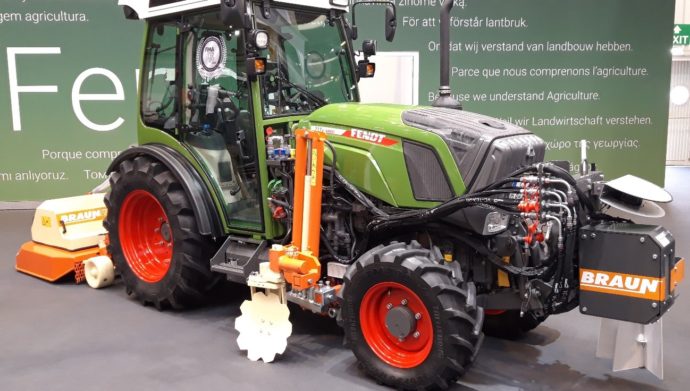Here we report on a joint development by Fendt and Braun Maschinenbau, presented at the 2020 edition of the International Fair of Agricultural Machinery (FIMA) held last February in Zaragoza, Spain. This development was awarded with the designation of technical innovation. It consists of a Fendt 200 Vario V/F narrow tractor hosting Braun equipment for precision viticulture. The latter includes two main sensing devices: A laser scanner mounted at the tractor front, and a gyroscope. The readings from both sensors are fed to the system control unit, or vineyard pilot assistant (VPA), which in turn sends commands to the tractor steering (through ISObus), to the left and right tractor mid-mounted implement, and to the rear mulcher. The tractor performs the steering commands and automatically drives in the middle of the alleyway. Active intervention of the tractor driver is only required at the plot headlands.
As the tractor moves along the alleyway, the laser scanner will generate a 3D map of the ahead scene in real-time. This map is a reconstruction of the ground contour, vine trunks, trellis posts, etc. The gyroscope marks the position and attitude of the tractor with regard to the 3D scene reconstructed by the laser scanner. Since the dimensions and position of the mid-mounted implement relative to the gyroscope are known, the VPA is able to compute the suitable implement adjustments.
The default mid-mounted frame implement is an indented-disc undervine weeder. Apart from mechanical, herbicide-free, weed control underneath the vines, this disc could be used for earthing-up the vine trunks. The VPA controls the working height and side shift of both the left- and right side undervine weeder independently. Moreover, the VPA controls the working width of the rear mulcher.
Conventional undervine weeders can be mechanical, hydraulic, or electric-hydraulic (Gil Sierra, 1990). All of them require mechanical contact of a feeler with the vine trunk to work. In contrast, the system developed by Braun and Fendt, which relies on the 3D map generated by the laser scanner, is contactless. The main benefits claimed for this development are: i) lower stress for the tractor driver; ii) increase of working speed and subsequent throughput (ha/h); iii) environment protection, due to removal of herbicide use; and iv) reduction of soil compaction enabled by less orchard cross-over due to the work of several implements in a single trip.
References
Gil Sierra, J. (1990). Maquinaria para el cultivo y recolección de la vid. Agroguías Mundi-Prensa.

